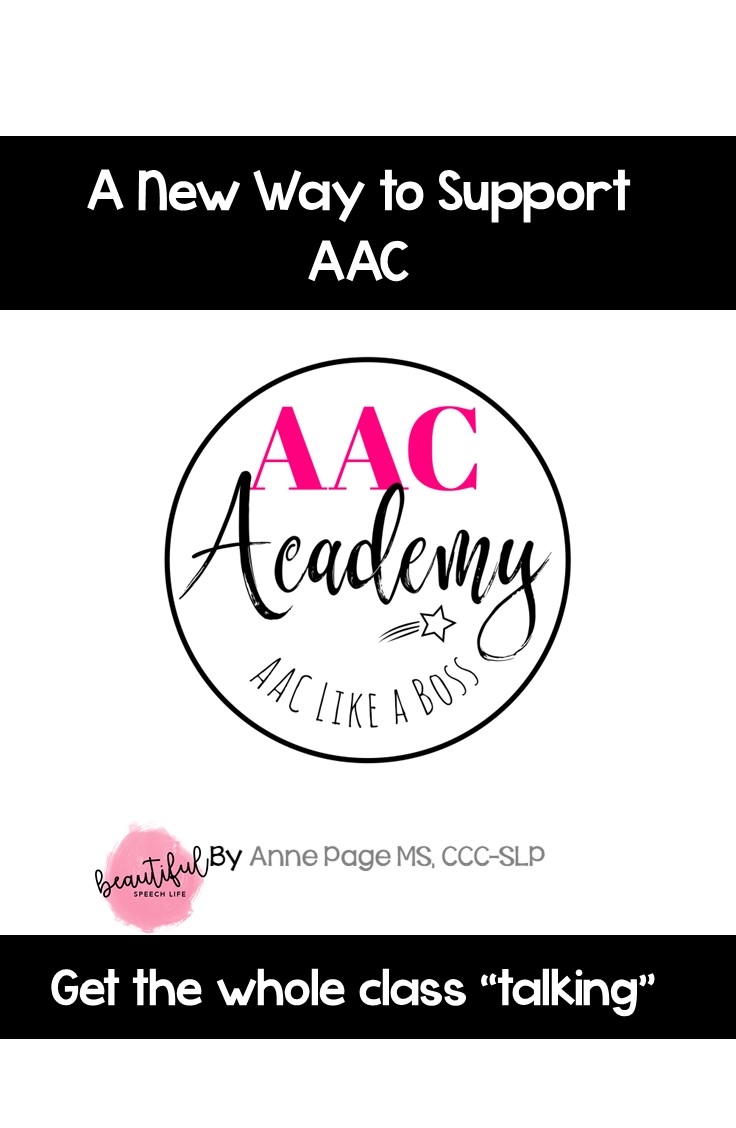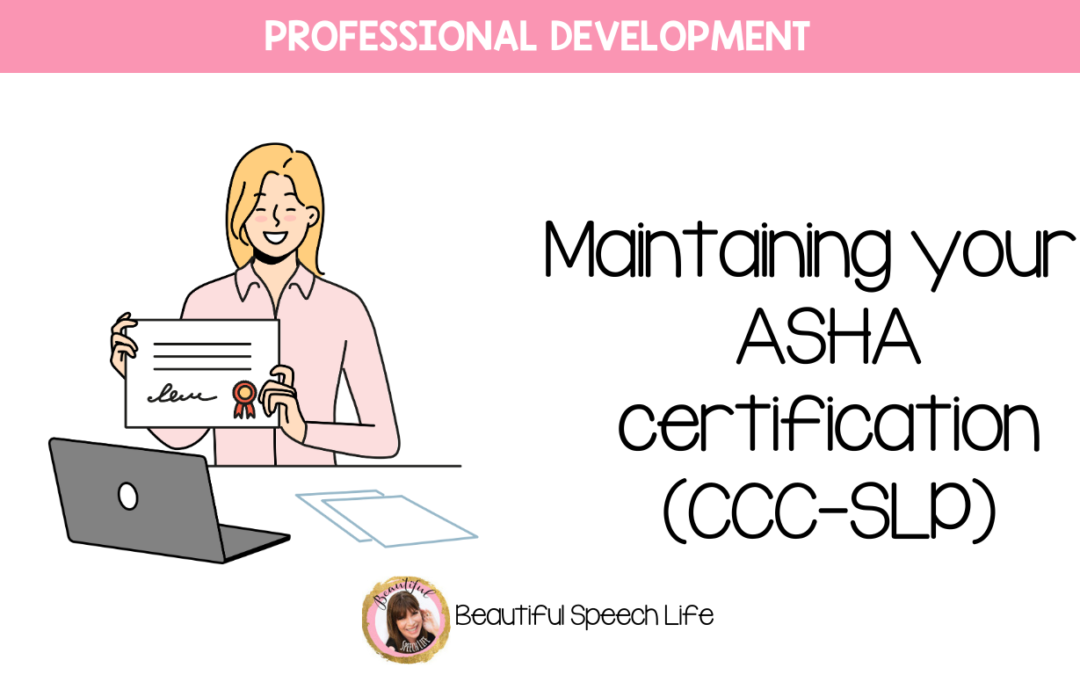
by Anne Page | Oct 29, 2023 | SLP Like a Boss
Maintaining your ASHA certification (CCC-SLP) is one of the ways we demonstrate as speech language pathologists, our commitment to supporting our students. If you have an ASHA Certificate of Clinical Competence (CCC-SLP) then you’ll know that to maintain this ASHA Certification you’ll need to accumulate 30 Professional Development Hours (PDHs) during each 3-year certification maintenance interval. You can read the requirements here on ASHA website. You might also see people talking about CEUs
1 PDH = one hour = 0.1 ASHA CEUs
10 PDH = ten hours = 1.0 ASHA CEU
There are also new requirements that at least one hour must be in the area of ethics and at least 2 hours must be in cultural competency, cultural humility, culturally responsive practice, or diversity, equity, and inclusion (DEI). The ASHA website has all the details.
But what can you do to meet these requirements?
AAC CEU courses
These are activities that have been preapproved by ASHA and you can sign up for the ASHA CE registry to track your hours. Once you’ve reached the 30 hours then your compliance form will be automatically submitted. If you are selected for a maintenance audit then you aren’t required to show evidence or report your activities.
CEUs and the registry are very convenient but what’s kind of confusing is how they’re calculated.
Here are some places where you can find free ASHA CEUs and paid PDH (previously called CMHs)
- ASHA’s website offers a variety of free CEUs, including webinars, podcasts, and articles.
- Many universities and colleges offer free CEUs to their alumni.
- There are also a number of professional organizations that offer free CEUs to their members.
- Finally, you can sometimes find free CEUs by attending conferences or workshops.
Please note that not all free CEUs are created equal. Some may be more valuable than others, so it’s important to do your research before you sign up for any.
Professional Development Hours (PDH)
Professional Development Hour (previously called a certification maintenance hour or CMH). The benefit of PDHs is that they don’t have to be ASHA-approved. (Check here) Just stick with this list and you don’t need to check with ASHA. You will need to keep track of these hours on your own and be able to provide verification of participation if audited.
The list is broad and includes business and management courses and teacher-oriented content as well as activities more directly linked to speech, language and hearing.
My favourite AAC training for SLPs
One of my favourites is the AAC Institute’s Introduction to AAC which is available here. This course is aimed at people who are new to using AAC and includes looking at what AAC is, identifying AAC stakeholders and classifying AAC interventions.
Saltillo is another great place to find courses. They not only provide training on using their products like Touchchat and Lamp Words for Life but also short courses on implementing these products. Some of their courses are registered for CEUs but not all. You can find out more about their training here. If you go to their implementation classes many are available for free free CEUs.
If you are looking for more hands-on-support and a community to learn with then I would love to see you in my AAC Jump Start Intensive Course. It’s the only course that will:
- Provide you with AAC coaching and support
- Give you the immediate tech knowledge you need
- Provide immediately actionable ideas and strategies
- Give you a crystal clear AAC roadmap to build your confidence.
Get all the details here and join the waitlist. On completion we can give you a certificate of completion for your records.
Maintaining your certification can feel onerous but it doesn’t have to be. There are so many great resources out there to help you develop your skills and become an even stronger partner for your students and their family.
Pin to read later:
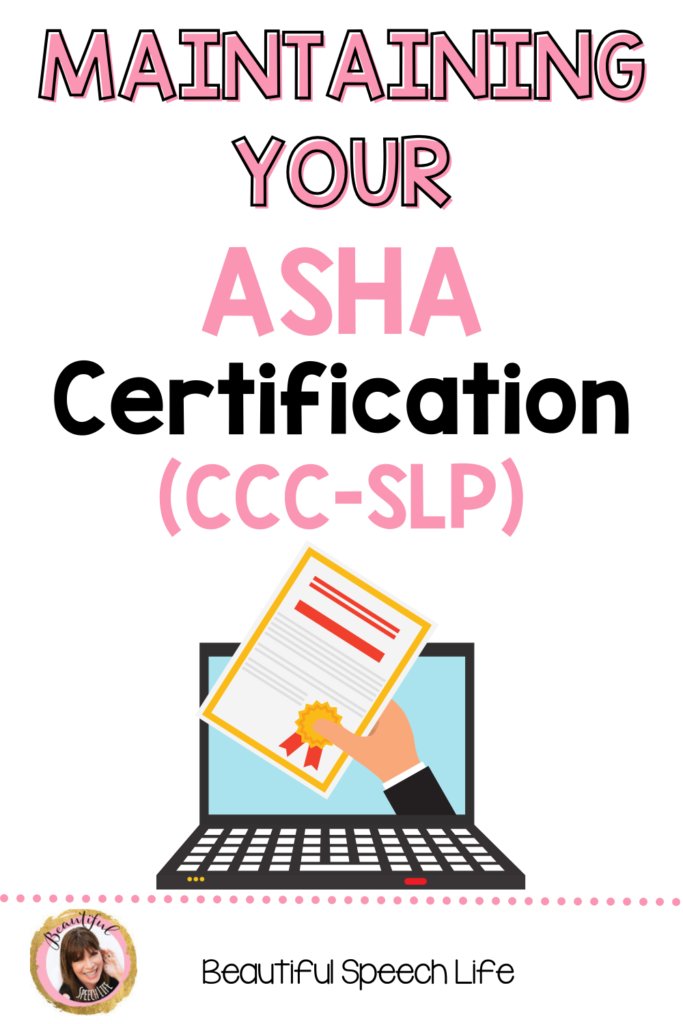

by Anne Page | Aug 1, 2021 | AAC, Parents, SLP Like a Boss, Therapy Ideas
I’ve shared before that we must view our young AAC users as a whole. As SLPs we need to consider each student’s home environment, their culture and all those times at school when we aren’t around to watch and model AAC for them. AAC use needs to occur everywhere, if the child is going to be successful with it.
Which means supporting and working with parents of emerging AAC users. It also means working with colleagues to support students and creating a team environment. As SLPs there is a lot we can do in this space. Including understanding the parents, helping them overcome barriers to access and seeking their input into plans.
Barriers families face
I work in a Title 1 school in the US and the families I work with often face barriers to getting access to AAC for their child.
Families, particularly those from diverse backgrounds are often not aware of their right to speak out and ask for things for their children. Or they don’t feel comfortable doing it.
That is if they know. For many of the families I work with, they are new to this country and don’t realize AAC devices even exist or that services are available. There is often not a translator to help them ask.
If they do know to ask, in many states there is a lot of red tape and phone calls around accessing the support. Adding this on to stresses that families are already facing can just be too much.
As SLPs we can advocate for the family and influence what device they get. We also need to keep advocating after that first device. We can make sure the student’s AAC changes with them as they grow. The child may have gotten a Big Mac and now has more capability. We need to make sure they have access to that. We can also advocate when devices get old or break. It’s so important to keep that connection with the parents and advocate for them.
If the student needs AAC to access education then it is the school’s job to provide it. We can make parents aware of this.
Involving parents (and colleagues)
Your student is not going to get the best outcomes if we don’t involve parents and our colleagues in supporting the students. I get a lot of questions about how to do this. It isn’t always easy but it is possible by:
- Building connections. As SLPs it’s our job to talk to the teacher and connect. If you’re doing an AAC evaluation then try to include everyone on the team. Give whoever is going to work with the child an opportunity to provide input and feel like they’re part of the whole process.
- Keep lines of communication open at all times. Ask the teacher what are their goals for the student, what is in their IEP and how you can you help them to reach these goals. Asking where the communication breakdowns are right now is a great place to start.
- Don’t make assumptions with parents. It’s important we don’t lead with our egos. Seek first to understand which may mean backing up a bit and slowing down. Just know it’s going to be a process. It isn’t going to be an overnight change. It takes years and years of building and growing. Making sure to involve everyone where you can.
- Tell success stories. Have examples to share with colleagues and parents. You have to share these stories and get people excited and to see the possibilities. We want them to see what could happen.
- Accept people will make assumptions about you. When you go into a community for the first time, people will make assumptions about you and this is ok. Don’t think you can change those assumptions immediately. Hang in there and keep talking to people. Attend everything you’re invited to.
- Listen. I’m never the loudest person in the room, I’m more a person who watches. I don’t go in thinking I know everything. I let people show me who they are and have respect when learning about a different culture. I want my highest spirit to meet their highest spirit.
- No professional jargon. Be really aware of not using professional jargon when working with families. Use parent friendly language and then introduce what the different terms we use all the time mean. This then helps them navigate the system without you.
- Include the family. A key question is to ask parents is “what would you like your child to communicate?” You can also program family names into devices.
Promoting Culturally Responsive Therapy
I want the children I work with to embrace their communities and I want to encourage other SLPs to do this too. To facilitate this I do the following:
- Parent Groups. I’ve been facilitating these once a month via Zoom. They’ve been such great groups. I include parents and teachers and we talk about things like AAC and the importance of modeling as well as providing an opportunity for questions and answers. The parents have gotten to connect with each other which is so important.
- Free Facebook Group. I’ve got a free Facebook Group for speech therapists, speech therapist assistants, teachers and instructional assistants who work with children who use and/or need Augmentative Alternative Communication (AAC). This is a space to ask questions without judgement and to connect with others. You can request to join here: https://www.facebook.com/groups/theAACconnection.
- Speaking at conventions. I often speak at local and national conventions. Baslcally any opportunity where I get to share the message about AAC and culturally responsive therapy.
There is so much we can do to support our families and colleagues and I love seeing parents sharing their culture with their children.
Pin to read later:

by Anne Page | Jul 18, 2021 | AAC, Quick Therapy Tips for the SLP and SLPA, SLP Like a Boss
One of my strongest beliefs is that all children with complex communication needs should have access to support regardless of their background. As SLPs we have an important role to play in ensuring this.
But I know it can feel intimidating at first. Particularly if you’re also navigating AAC for the first time. I recently did an interview with Tamara Anderson from Building Successful Lives on this topic. You can find the interview here: https://www.youtube.com/watch?v=zeVMsp3xv-4
If video isn’t your thing, I’ve summarised why this is important to me and ways to support your students.
Why is getting AAC to all children who need it important?
It’s not just Alternative!
AAC has two AAs. But we focus on the alternative rather than the augmentative. It’s supporting the child with what they already have. If the child has very limited verbal speech then using AAC can be a bridge to developing bigger language skills.
It can also provide an alternative way for the child to communicate when they’re having a communication breakdown or when they’re really tired. I often see students with autism who under times of great stress or during times of sensory overload find visual communication easier than using verbal speech.
It’s important not to wait. We want to get AAC into a kid’s hands as soon as we think they need it. They can start building those important language skills straight away so they’re not behind.
Advocating for and creating diverse materials for AAC users with complex communication needs
There is so much you can do as an SLP in advocating for and creating diverse materials.
1. View the child as a whole. The first place I like to start is by creating a climate and environment where we’re viewing each child as a whole. This means not just looking at his disability or where he needs help with communication. It also means what environments are they communicating in at school and at home. This is going to be a way for them to communicate wherever they are, so thinking about that is a great place to start.
2. Include language spoken at home. We used to think that it was confusing for the child if they were using multiple languages. Studies have now shown this isn’t the case. Children with complex communication needs can be bilingual or even multilingual. This ties back into viewing the child as a whole. We don’t want to alienate parents from children. We want children to embrace their home life and culture.
Don’t just think about the language but also the different phrases they might use at home. There is a lot to think about. Words don’t always translate directly. You might find it difficult to find a translator if the language used at home isn’t a common language in your community. But I promise your efforts will be rewarded.
3. Appropriate icons and symbols. Can your children see themselves reflected in their apps and core boards? The skin tone of the symbols can play a part in this. In the last year some of the big AAC companies (Touchchat and Proloquo2go) are making it so much easier for us as SLPs to adjust the symbols in one step. Others are coming on board so keep an eye on the website of the apps your students are using.
4. What voice are you using? If you are using computer generated voices can you choose one to sound as much like the student would sound if they could speak? Acapela Group is doing wonderful work to create more diverse voices.
Increasing the language and literacy of AAC users
As well as the bigger picture activities listed above there are simpler actions we can take to increase the language and literacy of AAC users:
· Modelling. I talk a lot about the importance of modelling. That is we as the communication partner use the communication device as well. Even if you only have a core vocabulary board you can point too.
· Incorporating words. Your student may not be able to read, but they can often recognise words. If you’re doing a visual schedule you can still add words as the student can recognise what words are. They can have letter awareness.
We can also encourage playing with letters. This could be through playing with magnet letters or using a keyboard.
· Give them the gift of story. We all have wonderful stories to share and giving students the gift of story is one of my favourite things to do. To start, have some active engagement in books. Get creative and make it fun. If children have been read to in a boring way when they see a book come out they think it’s time to go to sleep.
See if you can figure out how to make it fun and exciting. I like using puppets, the Tarheel Reader site, and interactive books with velcro pieces. It’s all about not being boring. Children understand the power of stories.
Just like with any kid we want to find a book that the child is interested in. For example, If a child likes cars then find a book on cars.
Next Steps
If you’ve enjoyed this blog post and are looking for ways to build on your knowledge then some great ways to do this are:
- Reach out to other SLPs in your region or even on social media. On Instagram search on the hashtag #AAC. There are amazing SLPs on Instagram sharing all about AAC.
- Take some courses. Look for courses offering practical advice. Like my AAC Academy Jumpstart.
- You can get so hung up on AAC and how complex it is. But at the end of the day… it’s just language and we know what language is. Look at the child and see where they are in their communication skills. All kids are communicating even if not verbal. Figure out what the next step is. Where do you want them to get?
- Work out how the device works – google the devices – there are lots of videos out there. Reach out to other SLPs if you get stuck.
- If a student needs a device and they don’t have one, do you have an AAC specialist in your district and what is the policy? Start doing the research. We don’t want our students to miss out.
It may all seem very daunting but it’s the best feeling when you can give a voice to a student and a family.
Pin to read later:
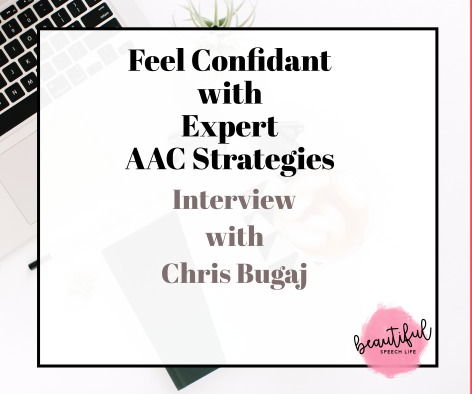
by Anne Page | Jan 13, 2018 | AAC, SLP Like a Boss
Want solid AAC and Assistive Technology ideas and tips for school speech therapy? Watch this engaging interview with AT Specialist Chris Bugaj. We talk about the importance of presuming potential, core vocabulary, motor planning, aided language stimulation and AAC in the IEP. You’ll also learn the AAC mistakes we both made.
Click below to watch or click here.

I was lucky enough to spend two days at an Assistive Technology workshop for school districts across Arizona led by Chris Bugaj. Chris is a Licensed Speech – Language Pathologist in Virginia with Certificate of Clinical Competence. He is also the founding member of the Loudoun County Public Schools’ Assistive Technology Team.
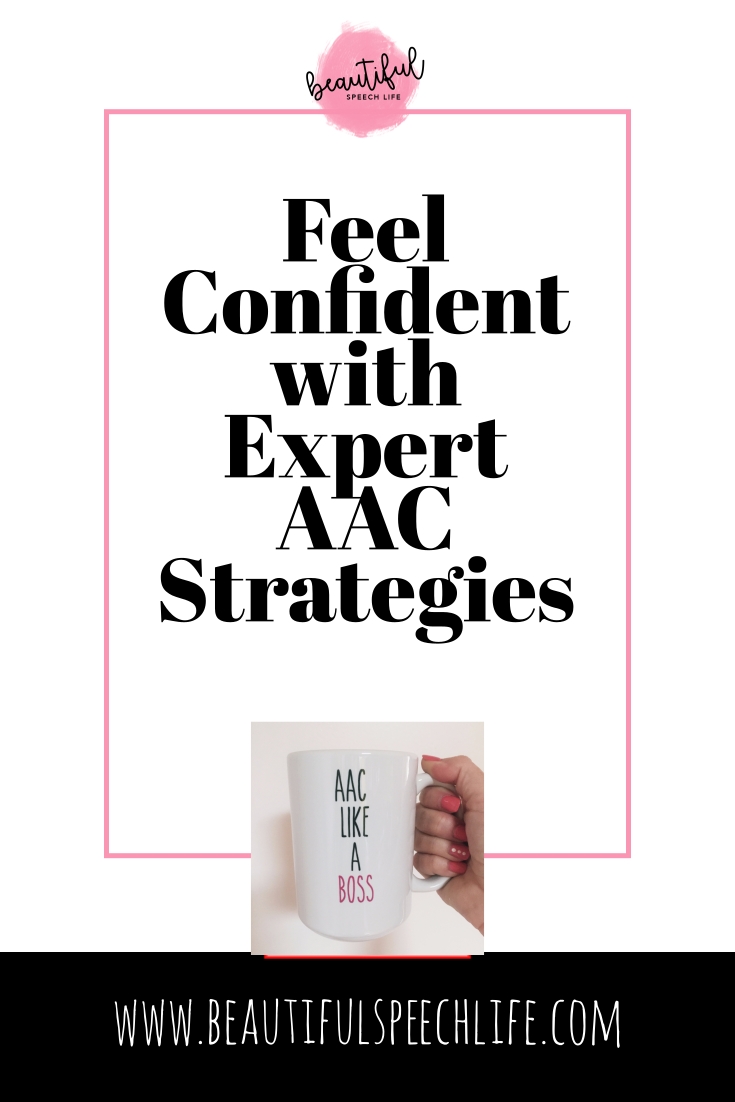
Chris is not only knowledgeable, he’s an engaging speaker with contagious enthusiasm for all things AAC and Assistive Technology.
Big AAC Takeaways You Don’t Want to Miss: (or advice for the new SLP who’s a little scared)
- You have to own this! If you’re inspired, you can inspire others.
- Believe in your student; presume potential.
- Understand the fundamentals of AAC.
- Aided Language Stimulation is a must
- You don’t write an AAC goal, you write a language goal. Lean on your language expertise to be able to write better goals.
Check out these highlights:
The staircase analogy 11:00
Core vocabulary and the cell phone analogy 15:23
Mistakes Chris and I both made 17:00
How to approach AAC and AT in the IEP 23:00
My “aha” moment (a different way to look at back-up AAC) 25:00
Resources:
http://bit.ly/aacquadrant
Where to find Chris Bugaj:
https://attipscast.com/
Twitter@Attipscast
Want to get started with Core Vocabulary but aren’t sure how? Click here Quick Inexpensive Way to Get Started with Core Vocabulary.


by Anne Page | Nov 24, 2017 | SLP Like a Boss
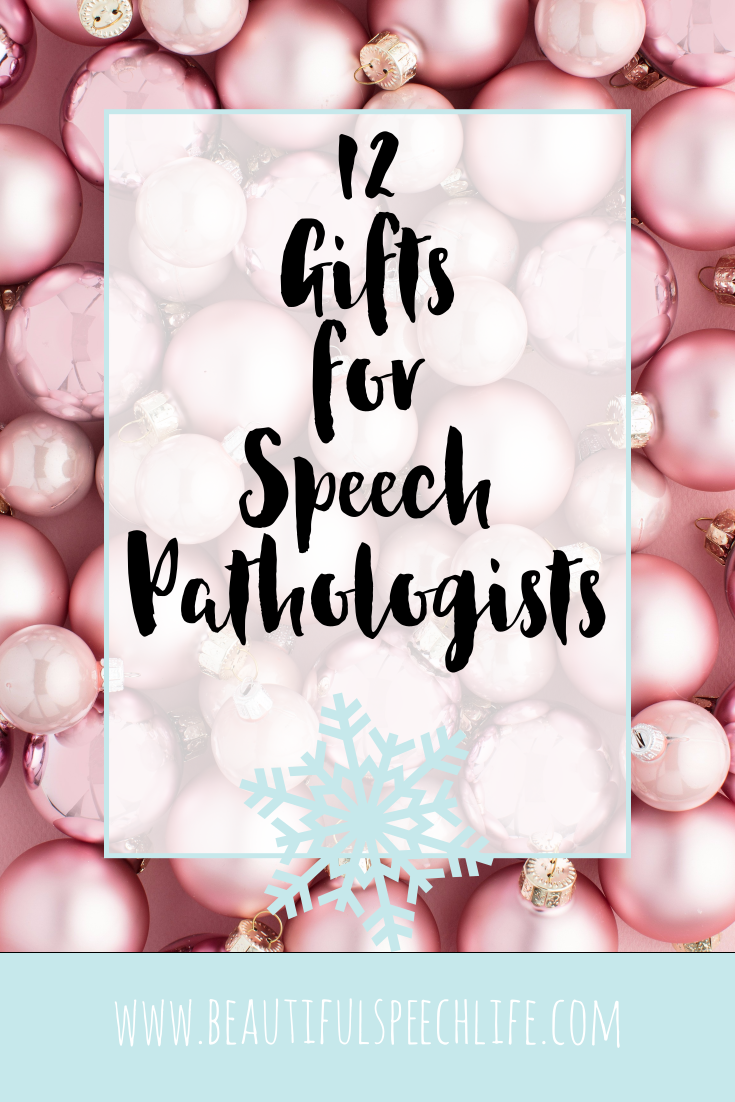 Struggling to find gifts for your Speech Language Pathologist friends that they’ll actually WANT? These speech language pathologist gift ideas are so fun and useful that they’ll probably be on her favorites list.
Struggling to find gifts for your Speech Language Pathologist friends that they’ll actually WANT? These speech language pathologist gift ideas are so fun and useful that they’ll probably be on her favorites list.
SLP gift ideas can be tricky. Whether you’re a parent giving a gift to your child’s SLP or you want something special for your SLP bestie (or wife or CF supervisor). I’ve got you covered for all price ranges. Especially if you’re buying for yourself my SLP friend.
This post contains affiliate links for your convenience.
1. A
Magic Wand to help her with her littles. This is always a hit in my therapy room.
2. The
Seven Year Pen. SLPs do sooo much paperwork and signing their names to IEPs, what could be better than a fun pen, that writes smoothly and lasts for seven years? I can’t get enough of these.
3.
SLP Like a Boss Mug. Most SLPs are fueled by coffee. What could be better than this big, inspirational mug that’ll remind her she’s got everything covered.
4.
A pink donut phone grip.We’re on our phones a lot! How about a pink donut grip to keep her phone accessible?
5.
The Five Minute Journal. Time is always a valuable commodity. With the small commitment of 5 minutes in the morning and 5 minutes at night, this journal will help her stay present and grateful.
6.
Flair pens because you can just never have too many.
7.
Planner stickers. You know we love to plan, sometimes it’s just too hard to by a planner for someone else. But these stickers will brighten up her day all year.
8. SLPs love words. Get her this
amazing light board for her desk so she can stay inspired.
9. Another pen? Yes! Because this
cactus pen will help her stay on point.
10.
More Tea Please mug. And another mug? Yes because maybe she likes tea instead of coffee. The sign language makes it perfect for the SLP or Special Education Teacher.
Here are a couple of bigger ticket items for the SLP that’s at the top of your nice list (or maybe for yourself if you’re an SLP)
1. If we’re talking about a school SLP, she has to do progress reports. Buy her a subscription to
SLP Toolkit. It’ll make her progress reports smooth and stress free.
2. Maybe she’s always wanted to learn
Sign Language. This online course is perfect for SLPs and special education teachers who need to know basic Sign Language vocabulary to use with clients, students, or patients in their speech therapy sessions.
Happy shopping, I know your speech pathologist will love one (or two) of these lovely gifts,


by Anne Page | Oct 27, 2017 | Inspiration, SLP Like a Boss
Who’s going to the ASHA Convention in LA this year? That’s where I’ll be November 9-11 and this will be my 5th ASHA convention. Honestly, with over 15,000 people atteding, it can be a little overwhelming. If you’re a first-timer (or even second or third), I’ve put together 10 tips to getting the most out of ASHA convention 2017.
Tip #1 Plan your courses ahead of time
I know sometimes it’s fun to just wing it, but this is not one of those times. You’re probably spending a lot of money on registration, hotel room, meals, and travel. Let’s get the most bang for your buck, grab your program pocket planner (you should’ve received it in the mail) and highlight some of the courses that look really interesting. Then you can look them up online here.
Tip #2 Plan to make some connections
Think about what specific topics you’re most interested in. Maybe this is an area where you’d like to connect with like-minded SLPs. Show up early for the course so you can talk to some of the people sitting next to you. Even if you’re shy, it’s to say something like “I’m excited about this course” or “how’s the convention going for your so far?”, just break the ice.
Talk to the presenters after their talk.
When you’re walking around if you see an SLP blogger or TPT seller that you follow on social media, say hello.
Tip #3 Show up Early
Some of the courses fill up quickly, so there early and grab a good seat for yourself. It’s no fun standing against the back wall for being in the overflow room.
Tip #4 Bring snacks
Your brain is going to be on overload with all this great new information and just from the energy of being around so many people. You’re going to want to feed it and lots of times the lineup for snack items is really long. I like to bring almonds, trail mix, protein bars and a water bottle. (You’re going to thank me for this tip.)
Tip #5 Plan lunch
Plan ahead for your lunches. If you have back to back courses it’s pretty tricky to leave the convention center and get back on time. Because, let’s face it, everyone’s got to eat, so the restaurants get really crowded. I usually do a combination of the ASHA prepaid lunches and snacks. Or you could plan to skip one of the 1:00 sessions and have a fun lunch with some of your SLP friends. Yes, it’s okay, you don’t have to go to every time slot. It’s important to connect and network too.
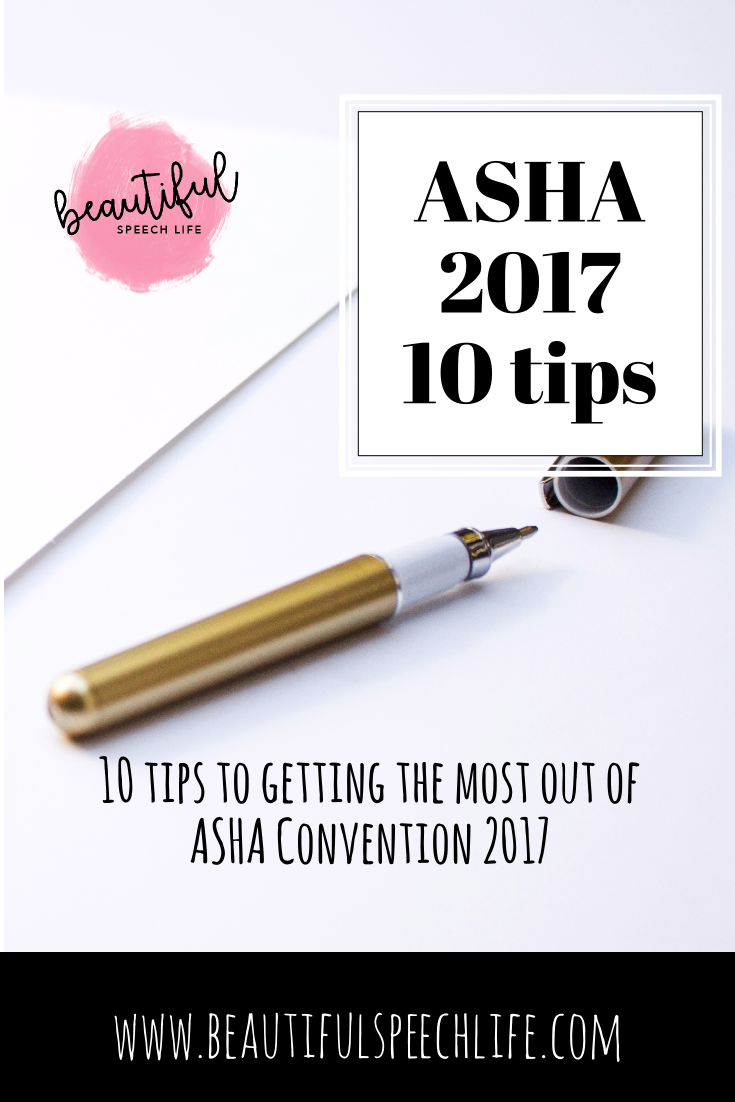
Tip #6 Remember shoes are everything
Really consider your footwear. You’re going to be walking a lot and standing a lot in the Exhibition Hall, so keep it comfortable and profesh.
Tip #7 Bring layers
Of course, you can dress however you want. Remember you’re going to be sitting a lot, so you want to be comfortable. But you’re going to want to look professional too, (at least I do). I plan to dress in layers, because you never know what the temperature’s going to be like in each room. There’s nothing worse than trying to concentrate when you’re freezing or roasting.
Tip #8 Plan your Exhibit Hall Attack
The first few times, it can be a little overwhelming because it’s HUGE. Get the floor plan that comes with your registration packet and have a look. (Or look at Tip #10) Does that sound geeky? I just remember my first time. I didn’t have a plan and I ended up getting completely overwhelmed and exhausted. Now I do it differently. I go through the floor plan and highlight all of the booths I know I can’t miss. Then, I make sure I go to those first. I also schedule myself a nice block of time to look at things.
This is a great opportunity to check out some of the big vendor’s booths. There’s always tons of swag. Super Duper has a huge area (it’s like a store), where you can actually purchase therapy materials. They also give you a big huge tote bag to carry everything in. Again, plan ahead, you don’t want to be caring that huge bag with you all day to all your classes.
Tip #9 Explore and have some fun
Take advantage of being somewhere different. Go to some of the meetups, check out a fun restaurant, and maybe you’ll even have time to go to the beach.
Tip #10 Get the ASHA 2017 Convention app.
This free app allows you to sync your schedule and see your friends schedule. It also has maps and a What’s On Now feature to keep you totally in-the-know.
That’s all for now. I hope you find these ten tips helpful and I would love to see you in Los Angeles! I’ll be posting on Instagram (Beautiful Speech Life) and maybe even Facebook Live.
One of the best things about going to an ASHA convention is connecting. We all work so hard, it’s nice to have time to socialize with people who speak our language.













 Struggling to find gifts for your Speech Language Pathologist friends that they’ll actually WANT? These speech language pathologist gift ideas are so fun and useful that they’ll probably be on her favorites list.
Struggling to find gifts for your Speech Language Pathologist friends that they’ll actually WANT? These speech language pathologist gift ideas are so fun and useful that they’ll probably be on her favorites list.


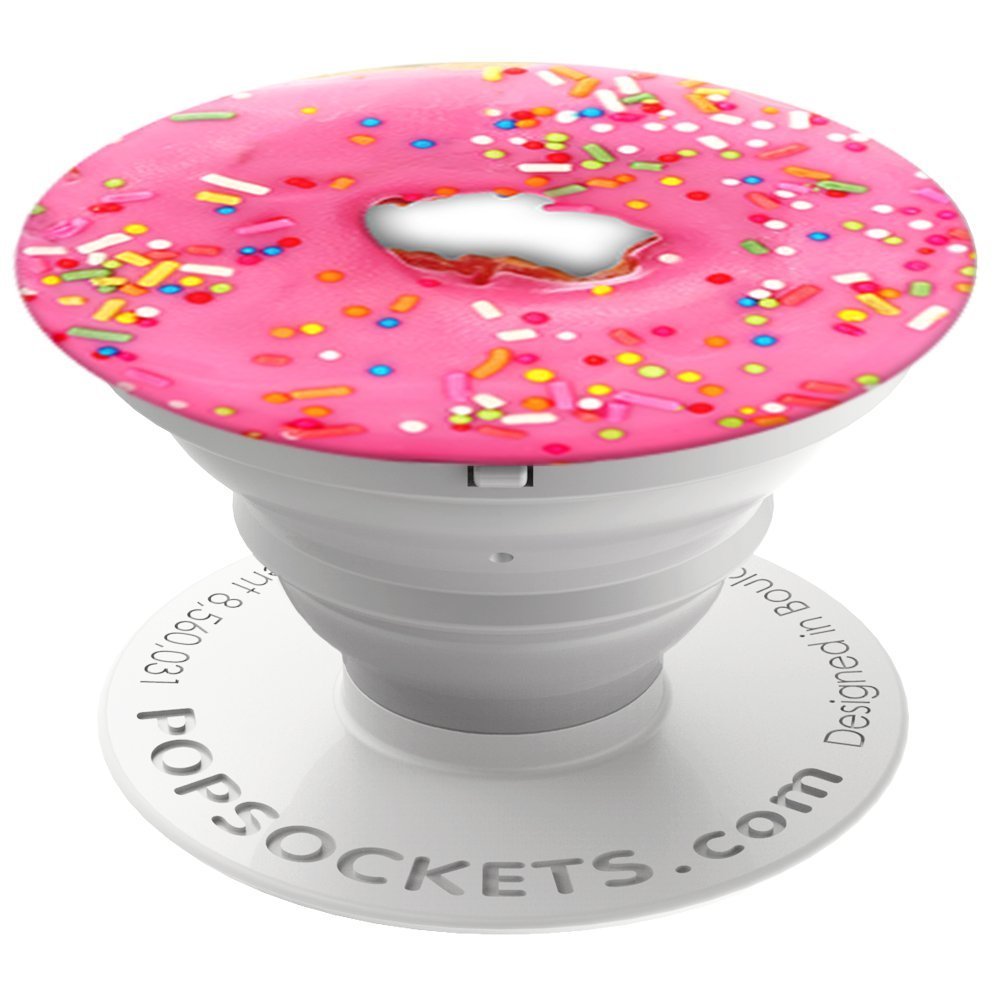

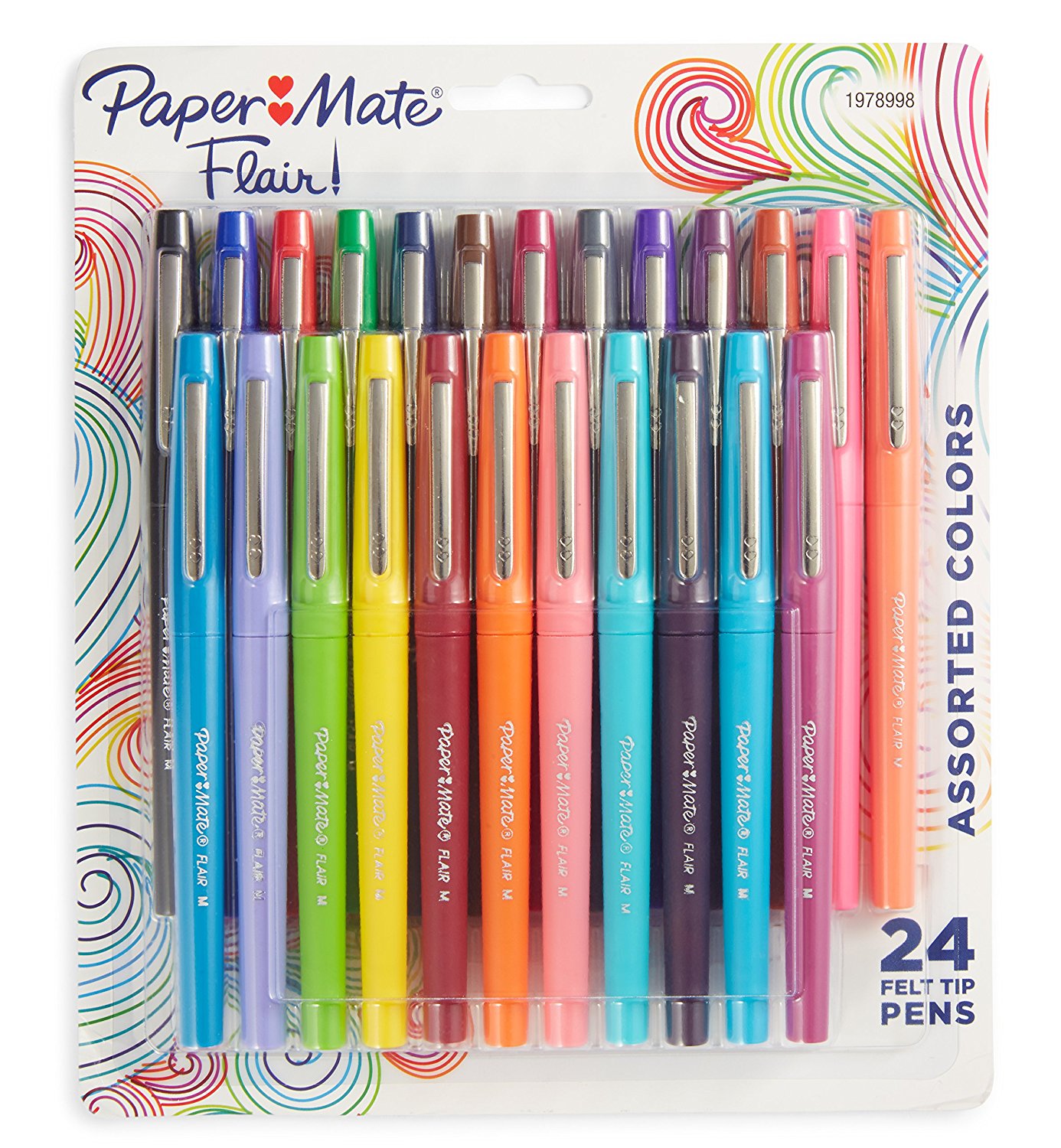
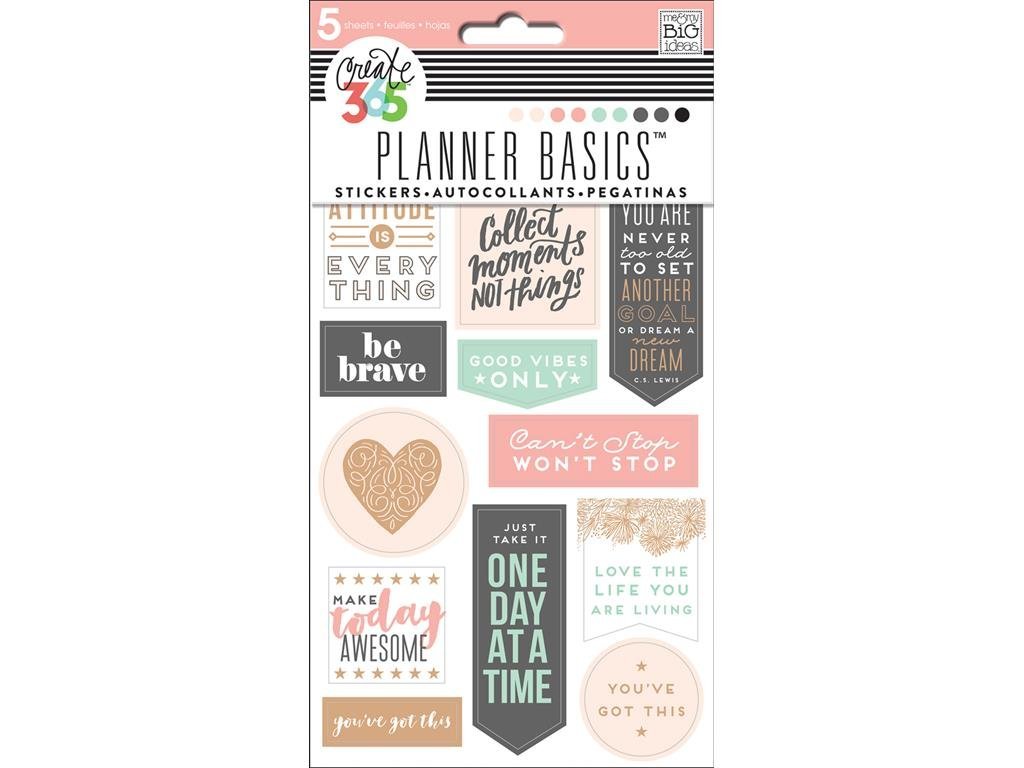

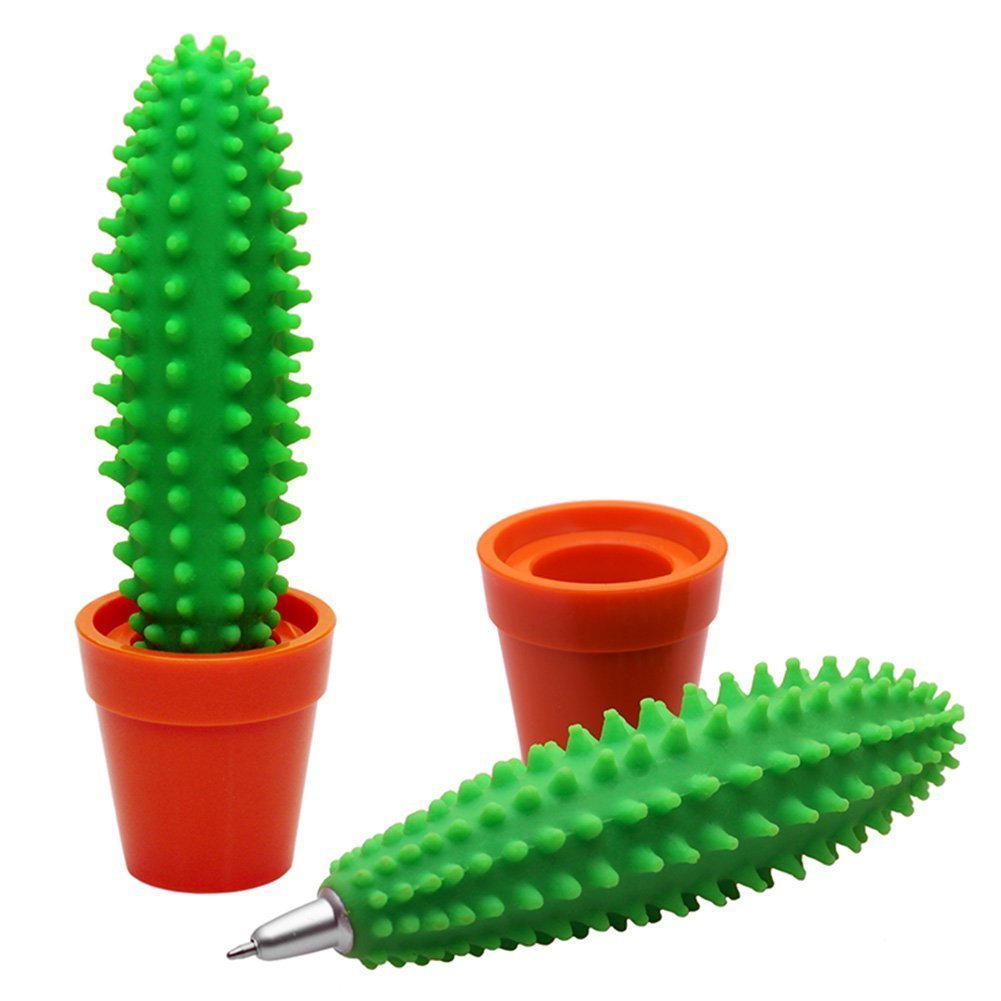


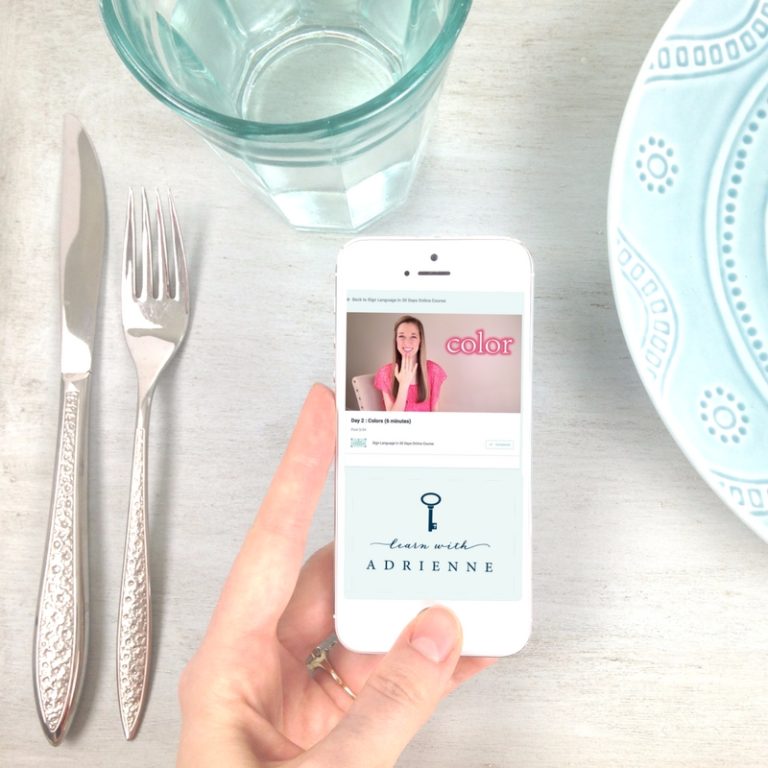


 Hey there I’m Anne Page. I help heart centered SLPs and educators put the fun in functional communication.
Hey there I’m Anne Page. I help heart centered SLPs and educators put the fun in functional communication. 